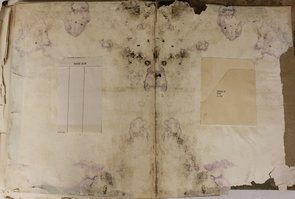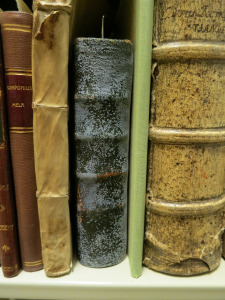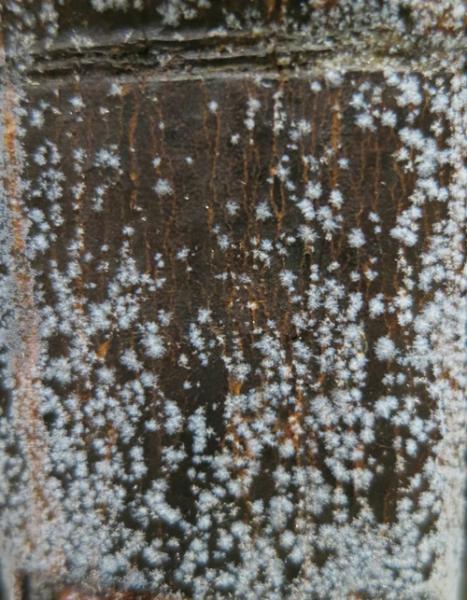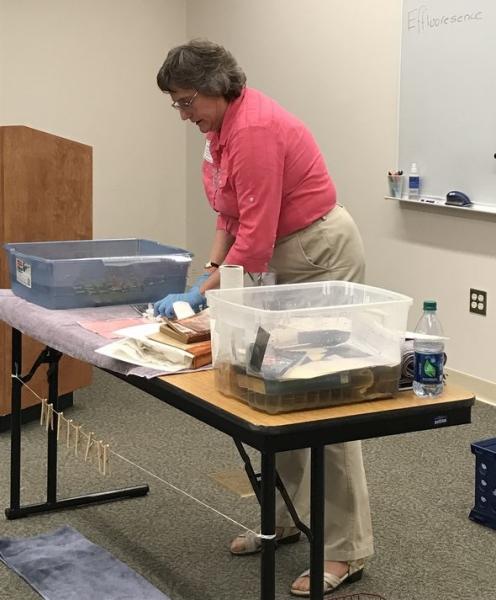What can you learn from a workshop titled: Salvaging Mold and Water Damaged Library Materials: A Preservation Workshop
Mary Burns, Northern Illinois University, and Melanie Schoenborn, Southern Illinois University Edwardsville
As a book conservator, I attended this workshop to continue my awareness of mold and the effects it can have on our library collection as well as learn about new treatments and if there are treatments that are no longer recommended. I was looking forward to the hands-on salvage demonstration so that I would be better prepared for a future water disaster. – M. Schoenborn
As a rare books and special collections cataloger, I thought the workshop was very beneficial. Catalogers often encounter foxing, dormant mold, and sometimes active mold. Understanding more about all of these issues makes catalogers more attune to potential problems. If they can recognize them, they can then bring them to the attention of preservation staff before the problem becomes worse. – M. Burns
What is mold and what isn’t mold?
Mold Photographs:


Jennifer Hain Teper, Head Preservation Services at UIUC shared her knowledge about mold, mold damage, and conservation of mold damaged library materials. Participants learned how mold grows and the environmental conditions that foster its development. The difference between active and inactive mold, foxing and efflorescence were explained. Past and current practices for treating mold were highlighted. Jennifer also shared her experiences with the conservation of mold damaged library materials from two case studies of disasters that occurred within her purview at UIUC.
One of the disasters was from a steam pipe breaking and spewing direct steam for an unknown period of time into an enclosed basement where library materials were stored. The other was a white mold outbreak in their Rare Book and Manuscript Library. The steam pipe breaking was handled similar to a flood, and a vendor was on call because they had developed a relationship when creating her library’s disaster plan. Library staff assisted in getting items to freezer compartments brought in to rescue the collections. The library was able to minimize the loss of materials.
Mold by many colors is still mold, or is IT?
White Mold:

Efflorescence:
Efflorescense on book spine:

Efflorescense close up:

The white mold outbreak caused the University of Illinois to close its Rare Book and Manuscript Library to keep contamination to a minimum. A vendor was also used in this remediation process, but due to the value of the items in this Library, all cleaning and conservation work was supervised or viewed by UIUC staff at all times in a contained work area. The difficulty with this disaster was that white mold is very difficult to distinguish from efflorescence which is also white. Visually efflorescence looks like white dust spread over an area of the book. On the spines of books it is concentrated in areas of depressions, ridges, or lettering. Efflorescence is not a fungi but a crystalline residue caused by deteriorating leather dressing previously applied to help preserve the binding. It was intended to help the leather cover stay supple. Cases of efflorescence and/or white mold had been discovered in some of this rare library's items. These items needed cleaning and/or treated for mold and all of the shelving had to cleaned.
During the remediation, cleaned shelving and cleaned items needed to be kept separate from items waiting for shelf cleaning and conservation. Materials housed in archival boxes, binders, and sleeves had to be removed and new enclosures needed to be created. One of the resources shared during the workshop is sited below to help with distinguishing efflorescence from white mold (no longer available online, May 29, 2019).
When to salvage or withdraw? What is salvageable? How do you decide?

Our water salvage demonstration was a hands-on training session presented by Bonnie Parr, Historical Documents Conservator, Abraham Lincoln Presidential Library and Museum. She had prepared individual bins of water damaged materials and all of the supplies needed to salvage of the items in the bins including our own clothes lines with pins. Bonnie reviewed the types of materials in our salvage operation. The process and materials needed for drying or processing for conservation of each type were viewed for clarification. Bonnie demonstrated how to salvage books, documents, photographic materials, film, CDs, DVDs, cassette tapes, and videotapes. View her handout for more information.

Bonnie also covered the need for a disaster plan and the processes that are involved before, during and after a salvage operation. She shared an online resource bibliography of water damaged library resources.

